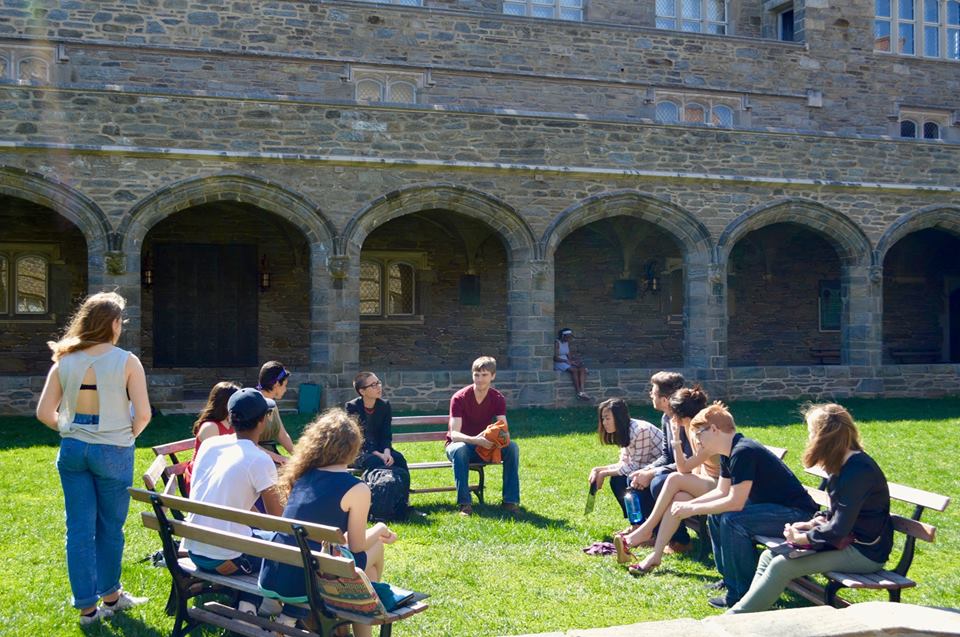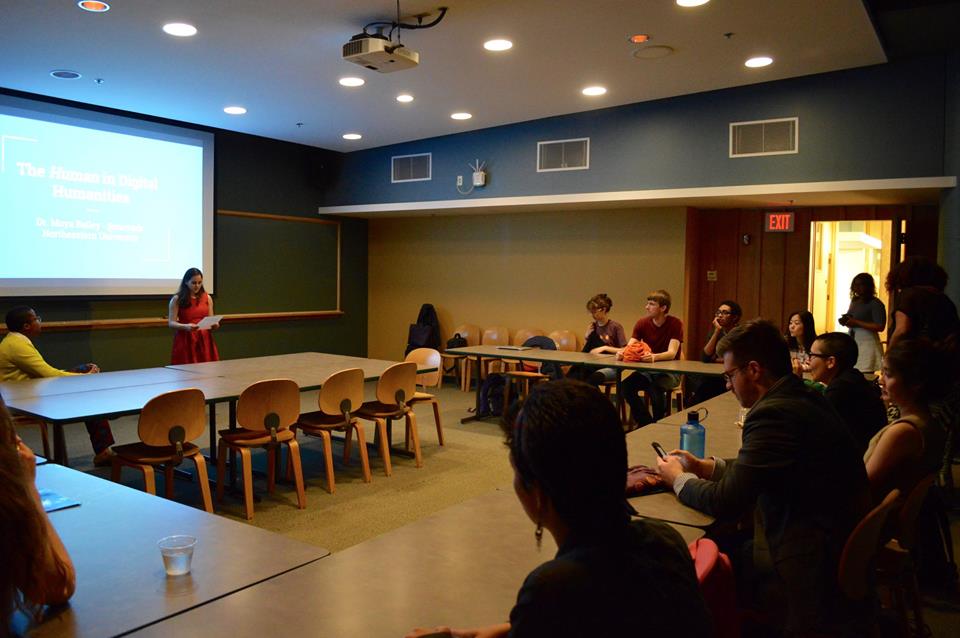Yesterday was the second and final day of Re:Humanities 2016: Bleeding Edge to Cutting Edge. (For Day 1, read here.) The day was filled with undergraduate student presentations and a workshop led by Moya Bailey, a Dean’s postdoctoral scholar of Women’s, Gender, & Sexuality Studies and Digital Humanities at Northeastern University.
The day started early at 8:30am in Quita Woodward Room for breakfast, then continued in Carpenter 21 for student presentations, then lunch, workshop, and wrap up.
First up, my friend Amy Xu, BMC’17 presented on “Epistemic Injustices in Big Data.” Citing corporations like Airbnb, Target, and Princeton Review, Amy pointed out how corporations were using algorithms and predictive analytics on big data from the general public (such as median household income, racial distributions, Internet browsing habits, etc.) to reinforce systems of privilege, division, and singling out. Amy made the example of Flushing, Queens, where the median household income is not high, but the racial distribution of many Asians determined the higher than average SAT prep pricing in the area. Just because people don’t notice these differences of treatment doesn’t mean it’s not injustice. While data scientists are people too, capitalism may be seen as the driving force behind those constantly looking for profits and self-interest.
Next, Mahmoud Aliamer, UChicago’17, presented on “Beyond Fingerprints: Computational Methods of Genre Classification.” Aliamer shared with us his project blending computer science with comparative literature to decode and translate classics such as Lolita, Ernest Hemingway, jazz, languages, and novels. He found that translations were connected to time, era, collections, series, etc. so it was difficult to make his computer program accurately translate inputs.
Hannah Weissman, HC’17, presented on Cellphone Usage Among Young Adults. She told us how she became curious of the impact of smartphones in our lives through taking the Bryn Mawr class ED255: Education, Technology, and Society taught by Alice Lesnick. Her responses found that young adults, primarily in the Bi-Co, use their smartphones as a distraction, to search information, time, and communication. Could the young adults change their tech habits and live without a phone? Most reported to use their laptops more in its place.
Tania Uruchima, SC’16, presented on “We Are (Not) Here To Teach You: Race on Tumblr.” Uruchima was fascinated by what she was learning about race in society on Tumblr in ways she was not taught in class. She concluded that Tumblr is in fact a form of activism, not slacktivism. Tumblr was a space for marginalized identities, such as WOC and LGBTQ+, to reclaim their voices and reshape their narratives. Tumblr was a way of seeking environment that works for the kinds of conversations you want to have — let’s not get into reddit.
 Next, Malin Jornvi, NYU Tisch’18, presented on Finding Structures in data mining of literature across cultures.Text mining showed stark differences in translation between Fröken Julie and Miss Julie. The translated Miss Julie was associated with whore while the original version was not. Could these structures and association patterns be found without digital tools which facilitate humanities research? Are these patterns new, or were they always there? Jornvi asked us to think of digital humanities, perhaps, as just another effect of industrialization and modernization. Jornvi also questioned whether we really could create something (such as editions and translations) that does not have an original starting point in ourselves and our beliefs. The work of art is a dual process, never finished, never fully translated or interpreted.
Next, Malin Jornvi, NYU Tisch’18, presented on Finding Structures in data mining of literature across cultures.Text mining showed stark differences in translation between Fröken Julie and Miss Julie. The translated Miss Julie was associated with whore while the original version was not. Could these structures and association patterns be found without digital tools which facilitate humanities research? Are these patterns new, or were they always there? Jornvi asked us to think of digital humanities, perhaps, as just another effect of industrialization and modernization. Jornvi also questioned whether we really could create something (such as editions and translations) that does not have an original starting point in ourselves and our beliefs. The work of art is a dual process, never finished, never fully translated or interpreted.
The concluding student presentation was by Swarthmore Digital Humanities interest group, Di.Hum, on The New Digital Humanities Manifesto. The group attempted to redefine what digital humanities was and what they wished it to be in the future. There was a heavy emphasis on digital humanities being done as as a “process,” not as it being an indescribable “thing.” The Manifesto is hosted on Squarespace.  The conference took a break for lunch, then reconvened for a workshop on “The Human in Digital Humanities” with Moya Bailey. Bailey talked about how her involvement in social justice in college at Spelman lead to her involvement in creating online spaces for Queer Black Girls and other marginalized identities in digital humanities. She then asked the participants and audience to share their first encounters with digital humanities. I shared how I got involved with Re:Humanities through an upperclassman Katrina Obieta, BMC’15, who I knew from Asian Students Association executive board. Although I did not conduct formal digital humanities research myself, I enjoy organizing the conference and absorbing other people’s research and conversations. We then discussed how the human experience may be left out of digital humanities when research is presented in inappropriate ways. Moya showed us data on lynchings organized in a table. There was no information on who those people were, just links to information about the county it happened in, the date, and the reason. Perhaps pictures of the people or words from the family members would have been more humanistic. Marisa Parham pointed out that this might not be a problem caused by digital humanities, but a problem with corporations and industries copyrighting privacy rights to such information like photos and primary sources integral to the story. We came to consensus that digital humanities must move in a direction toward inclusion and accessibility.
The conference took a break for lunch, then reconvened for a workshop on “The Human in Digital Humanities” with Moya Bailey. Bailey talked about how her involvement in social justice in college at Spelman lead to her involvement in creating online spaces for Queer Black Girls and other marginalized identities in digital humanities. She then asked the participants and audience to share their first encounters with digital humanities. I shared how I got involved with Re:Humanities through an upperclassman Katrina Obieta, BMC’15, who I knew from Asian Students Association executive board. Although I did not conduct formal digital humanities research myself, I enjoy organizing the conference and absorbing other people’s research and conversations. We then discussed how the human experience may be left out of digital humanities when research is presented in inappropriate ways. Moya showed us data on lynchings organized in a table. There was no information on who those people were, just links to information about the county it happened in, the date, and the reason. Perhaps pictures of the people or words from the family members would have been more humanistic. Marisa Parham pointed out that this might not be a problem caused by digital humanities, but a problem with corporations and industries copyrighting privacy rights to such information like photos and primary sources integral to the story. We came to consensus that digital humanities must move in a direction toward inclusion and accessibility. 
By the end of the conference, many of us were tired from our long, but collaborative, day. We finished with a wrap up session in the cloisters on pros and cons of the conference and things we learned. One of the suggestions for next year was to get more audience members from students at the host school. The observer show up was a little disappointing to me because I was the one responsible for postering around Bryn Mawr, spamming the facebook groups about the event, emailing the listservs, and trying to get Bryn Mawr College to promote my event. I think it’s difficult to promote events on weekdays when students may have class. However, I could think of many student groups on campus that would have benefitted from the conversations we were having at Re:Humanities. The digital humanities have as much to do about computer science, statistics, math, physics, biology, chemistry, etc. as it has to do about history, english, literature, languages, sociology, psychology, anthropology, etc.
Although Re:Humanities is marketed as a Tri-Co thing, most resources come from the Hurford Humanities Center at Haverford. Even our conference photographers were imported from Haverford’s Hurford Center to photograph the event at Bryn Mawr. It saddens me a little that Bryn Mawr does not have a Humanities Center. (Though I hear we are getting Maker Spaces? Maybe this could substitute this gap?) I’ve shifted some of my dedication to Haverford to make the connections and networks that have allowed me to thrive as a leader for Re:Humanities and many of the wonderful programs the Hurford Center has to offer (Social Medicine Seminar, Asian / American Reading Group, CPGC, film screenings…). I look forward to Re:Humanities 2017 at Haverford College next year! Perhaps I will present on censorship and civil society in China as I learned about in my Bryn Mawr POLS 334 class: Three Faces of Chinese Power. Or maybe on the connections between Physics and Digital Humanities…
